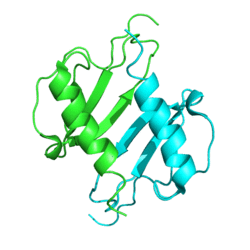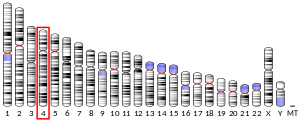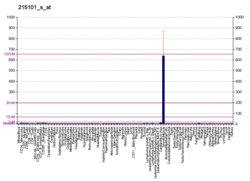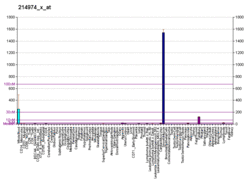C-X-C motif chemokine 5 (CXCL5 or ENA78) is a protein that in humans is encoded by the CXCL5 gene.[3][4]
Function
The protein encoded by this gene, CXCL5 is a small cytokine belonging to the CXC chemokine family that is also known as epithelial-derived neutrophil-activating peptide 78 (ENA-78). It is produced following stimulation of cells with the inflammatory cytokines interleukin-1 or tumor necrosis factor-alpha.[5] Expression of CXCL5 has also been observed in eosinophils, and can be inhibited with the type II interferon IFN-γ.[6] This chemokine stimulates the chemotaxis of neutrophils possessing angiogenic properties. It elicits these effects by interacting with the cell surface chemokine receptor CXCR2.[6] The gene for CXCL5 is encoded on four exons and is located on human chromosome 4 amongst several other CXC chemokine genes.[5][7] CXCL5 has been implicated in connective tissue remodelling.[6] CXCL5 has been also described to regulate neutrophil homeostasis.[8]
Clinical significance
CXCL5 plays a role in reducing sensitivity to sunburn pain in some subjects, and is a "potential target which can be utilized to understand more about pain in other inflammatory conditions like arthritis and cystitis.".[9] CXCL5 is well known to have chemotactic and activating functions on neutrophil, mainly during acute inflammatory responses. However CXCL5 expression is also higher in atherosclerosis (a chronic inflammatory condition) but is not associated with neutrophil infiltration. Instead CXCL5 has a protective role in atherosclerosis by directly controlling macrophage foam cell formation.[10]
References
- ^ a b c GRCh38: Ensembl release 89: ENSG00000163735 - Ensembl, May 2017
- ^ "Human PubMed Reference:". National Center for Biotechnology Information, U.S. National Library of Medicine.
- ^ Chang MS, McNinch J, Basu R, Simonet S (Nov 1994). "Cloning and characterization of the human neutrophil-activating peptide (ENA-78) gene". J Biol Chem. 269 (41): 25277–82. PMID 7929219.
- ^ "Entrez Gene: CXCL5 chemokine (C-X-C motif) ligand 5".
- ^ a b Chang MS, McNinch J, Basu R, Simonet S (1994). "Cloning and characterization of the human neutrophil-activating peptide (ENA-78) gene". J. Biol. Chem. 269 (41): 25277–82. PMID 7929219.
- ^ a b c Persson T, Monsef N, Andersson P, Bjartell A, Malm J, Calafat J, Egesten A (2003). "Expression of the neutrophil-activating CXC chemokine ENA-78/CXCL5 by human eosinophils". Clin. Exp. Allergy. 33 (4): 531–7. doi:10.1046/j.1365-2222.2003.01609.x. PMID 12680872. S2CID 2449190.
- ^ O'Donovan N, Galvin M, Morgan JG (1999). "Physical mapping of the CXC chemokine locus on human chromosome 4". Cytogenet. Cell Genet. 84 (1–2): 39–42. doi:10.1159/000015209. PMID 10343098. S2CID 8087808.
- ^ Mei J, Liu Y, Dai N, Hoffmann C, Hudock KM, Zhang P, Guttentag SH, Kolls JK, Oliver PM, Bushman FD, Worthen GS (2012). "Cxcr2 and Cxcl5 regulate the IL-17/G-CSF axis and neutrophil homeostasis in mice". Journal of Clinical Investigation. 122 (3): 974–986. doi:10.1172/JCI60588. PMC 3287232. PMID 22326959.
- ^ Dawes JM, Calvo M, Perkins JR, Paterson KJ, Kiesewetter H, Hobbs C, Kaan TK, Orengo C, Bennett DL, McMahon SB (July 2011). "CXCL5 Mediates UVB Irradiation-Induced Pain". Sci Transl Med. 3 (90): 90ra60. doi:10.1126/scitranslmed.3002193. PMC 3232447. PMID 21734176. Lay summary – FierceBiotech.
- ^ Rousselle A, Qadri F, Leukel L, Yilmaz R, Fontaine JF, Sihn G, Bader M, Ahluwalia A, Duchene J (2013). "CXCL5 limits macrophage foam cell formation in atherosclerosis". Journal of Clinical Investigation. 123 (3): 1343–7. doi:10.1172/JCI66580. PMC 3582141. PMID 23376791.
External links
Further reading
- Duchene J, Lecomte F, Ahmed S, Cayla C, Pesquero J, Bader M, Perretti M, Ahluwalia A (2007). "A novel inflammatory pathway involved in leukocyte recruitment: role for the kinin B1 receptor and the chemokine CXCL5". J. Immunol. 179 (7): 4849–56. doi:10.4049/jimmunol.179.7.4849. PMC 3696729. PMID 17878384.
- Walz A, Schmutz P, Mueller C, Schnyder-Candrian S (1997). "Regulation and function of the CXC chemokine ENA-78 in monocytes and its role in disease". J. Leukoc. Biol. 62 (5): 604–11. doi:10.1002/jlb.62.5.604. PMID 9365115. S2CID 20141618.
- Struyf S, Proost P, Van Damme J (2004). "Regulation of the immune response by the interaction of chemokines and proteases". Adv. Immunol. Advances in Immunology. 81: 1–44. doi:10.1016/S0065-2776(03)81001-5. ISBN 978-0-12-022481-4. PMID 14711052.
- Walz A, Burgener R, Car B, et al. (1992). "Structure and neutrophil-activating properties of a novel inflammatory peptide (ENA-78) with homology to interleukin 8". J. Exp. Med. 174 (6): 1355–62. doi:10.1084/jem.174.6.1355. PMC 2119025. PMID 1744577.
- Power CA, Furness RB, Brawand C, Wells TN (1995). "Cloning of a full-length cDNA encoding the neutrophil-activating peptide ENA-78 from human platelets". Gene. 151 (1–2): 333–4. doi:10.1016/0378-1119(94)90682-3. PMID 7828901.
- Corbett MS, Schmitt I, Riess O, Walz A (1995). "Characterization of the gene for human neutrophil-activating peptide 78 (ENA-78)". Biochem. Biophys. Res. Commun. 205 (1): 612–7. doi:10.1006/bbrc.1994.2709. PMID 7999089.
- Koch AE, Kunkel SL, Harlow LA, et al. (1994). "Epithelial neutrophil activating peptide-78: a novel chemotactic cytokine for neutrophils in arthritis". J. Clin. Invest. 94 (3): 1012–8. doi:10.1172/JCI117414. PMC 295150. PMID 8083342.
- Power CA, Clemetson JM, Clemetson KJ, Wells TN (1996). "Chemokine and chemokine receptor mRNA expression in human platelets". Cytokine. 7 (6): 479–82. doi:10.1006/cyto.1995.0065. PMID 8580362.
- Ahuja SK, Murphy PM (1996). "The CXC chemokines growth-regulated oncogene (GRO) alpha, GRObeta, GROgamma, neutrophil-activating peptide-2, and epithelial cell-derived neutrophil-activating peptide-78 are potent agonists for the type B, but not the type A, human interleukin-8 receptor". J. Biol. Chem. 271 (34): 20545–50. doi:10.1074/jbc.271.34.20545. PMID 8702798.
- Keates S, Keates AC, Mizoguchi E, et al. (1997). "Enterocytes are the primary source of the chemokine ENA-78 in normal colon and ulcerative colitis". Am. J. Physiol. 273 (1 Pt 1): G75–82. doi:10.1152/ajpgi.1997.273.1.G75. PMID 9252512.
- Wuyts A, Proost P, Lenaerts JP, et al. (1998). "Differential usage of the CXC chemokine receptors 1 and 2 by interleukin-8, granulocyte chemotactic protein-2 and epithelial-cell-derived neutrophil attractant-78". Eur. J. Biochem. 255 (1): 67–73. doi:10.1046/j.1432-1327.1998.2550067.x. PMID 9692902.
- Wyrick PB, Knight ST, Paul TR, et al. (1999). "Persistent chlamydial envelope antigens in antibiotic-exposed infected cells trigger neutrophil chemotaxis". J. Infect. Dis. 179 (4): 954–66. doi:10.1086/314676. PMID 10068592.
- Wuyts A, Govaerts C, Struyf S, et al. (1999). "Isolation of the CXC chemokines ENA-78, GRO alpha and GRO gamma from tumor cells and leukocytes reveals NH2-terminal heterogeneity. Functional comparison of different natural isoforms". Eur. J. Biochem. 260 (2): 421–9. doi:10.1046/j.1432-1327.1999.00166.x. PMID 10095777.
- Hogaboam CM, Bone-Larson CL, Steinhauser ML, et al. (1999). "Novel CXCR2-dependent liver regenerative qualities of ELR-containing CXC chemokines". FASEB J. 13 (12): 1565–74. doi:10.1096/fasebj.13.12.1565. hdl:2027.42/154508. PMID 10463948. S2CID 7043800.
- Luu NT, Rainger GE, Nash GB (2000). "Differential ability of exogenous chemotactic agents to disrupt transendothelial migration of flowing neutrophils". J. Immunol. 164 (11): 5961–9. doi:10.4049/jimmunol.164.11.5961. PMID 10820279.
- Crane IJ, Wallace CA, McKillop-Smith S, Forrester JV (2000). "Control of chemokine production at the blood–retina barrier". Immunology. 101 (3): 426–33. doi:10.1046/j.0019-2805.2000.01105.x. PMC 2327097. PMID 11106948.
- Zhang C, Thornton MA, Kowalska MA, et al. (2001). "Localization of distal regulatory domains in the megakaryocyte-specific platelet basic protein/platelet factor 4 gene locus". Blood. 98 (3): 610–7. doi:10.1182/blood.V98.3.610. PMID 11468158.
- Chandrasekar B, Melby PC, Sarau HM, et al. (2003). "Chemokine-cytokine cross-talk. The ELR+ CXC chemokine LIX (CXCL5) amplifies a proinflammatory cytokine response via a phosphatidylinositol 3-kinase-NF-kappa B pathway". J. Biol. Chem. 278 (7): 4675–86. doi:10.1074/jbc.M207006200. PMID 12468547.
- Strausberg RL, Feingold EA, Grouse LH, et al. (2003). "Generation and initial analysis of more than 15,000 full-length human and mouse cDNA sequences". Proc. Natl. Acad. Sci. U.S.A. 99 (26): 16899–903. doi:10.1073/pnas.242603899. PMC 139241. PMID 12477932.




